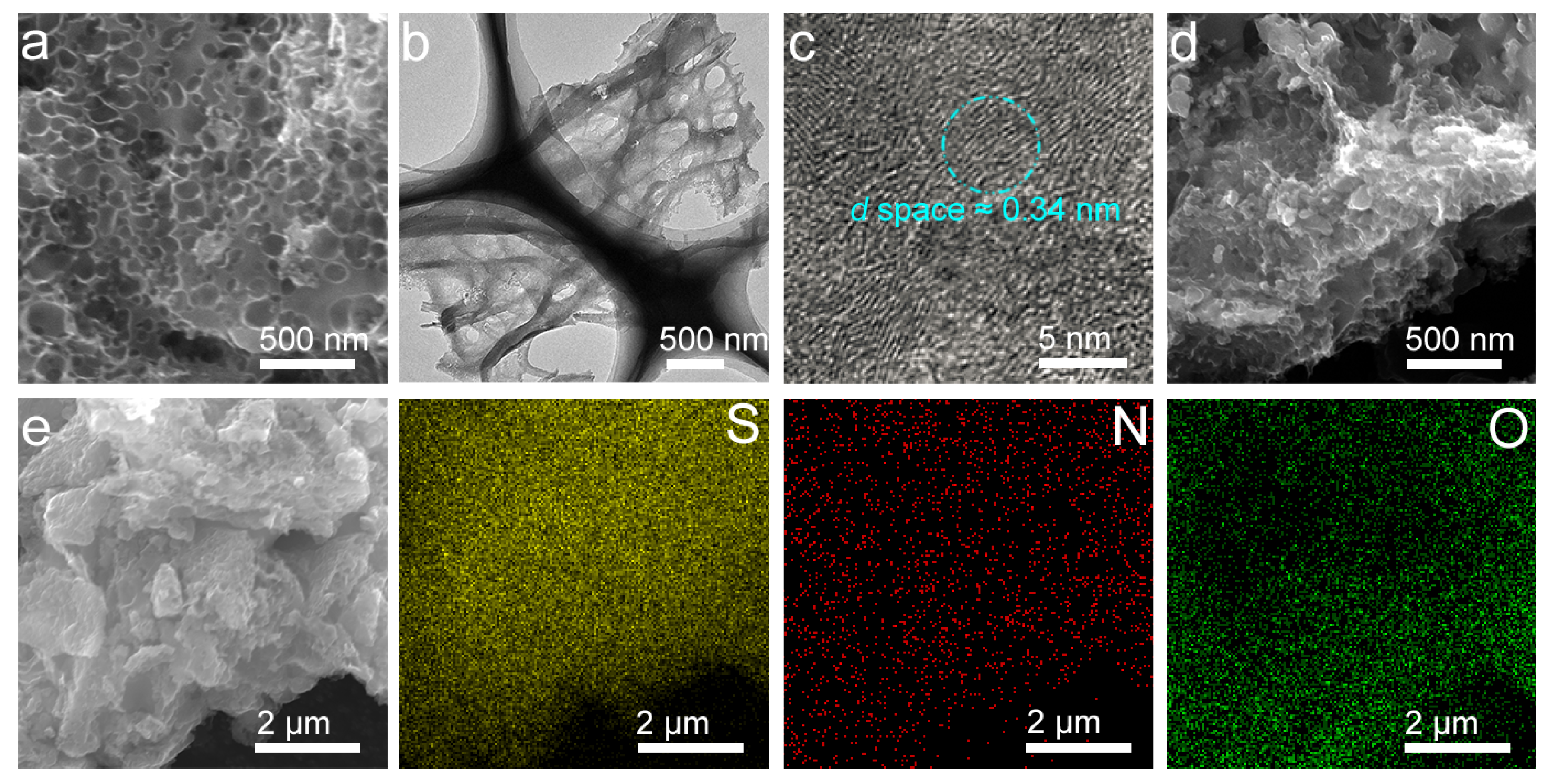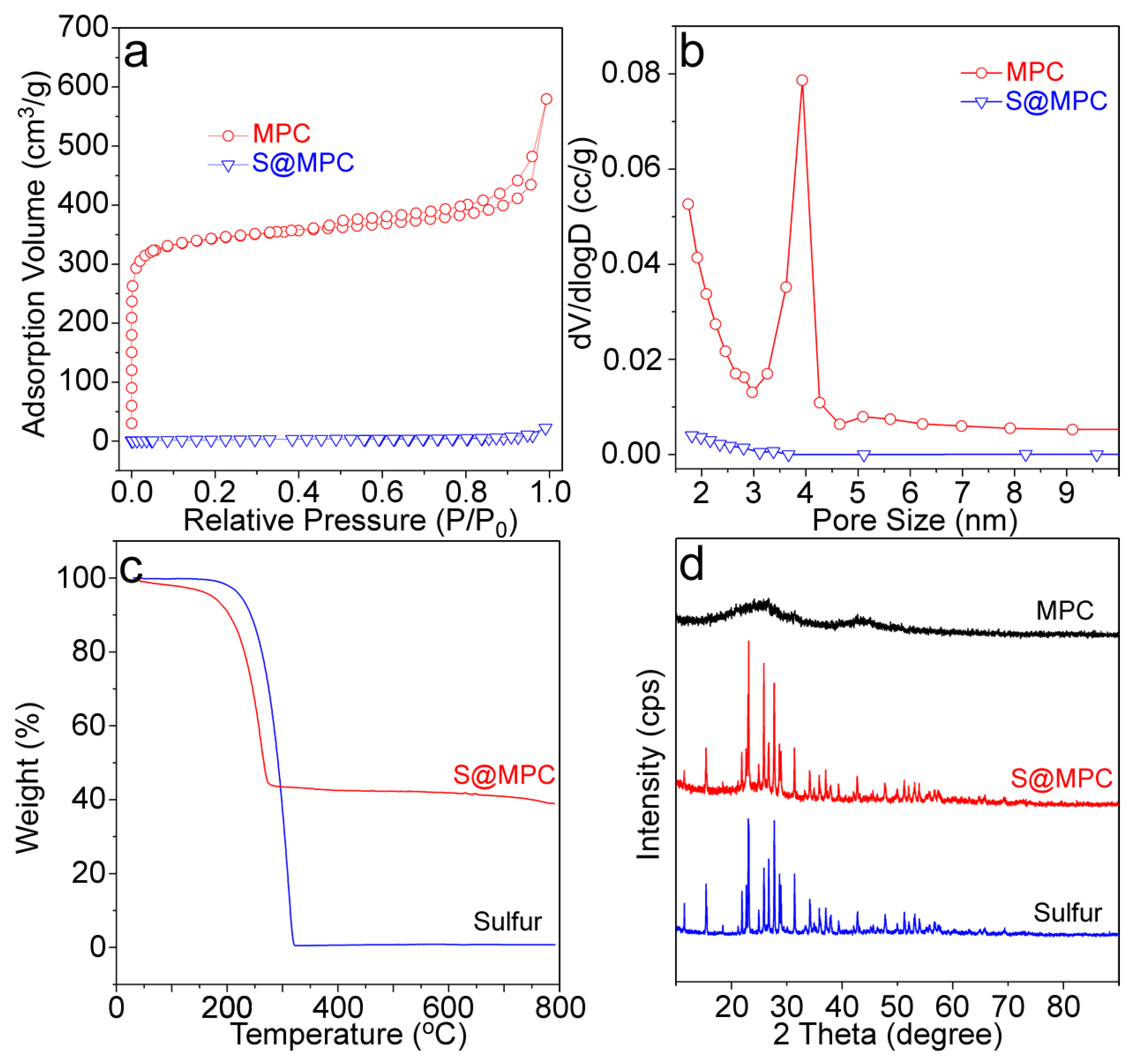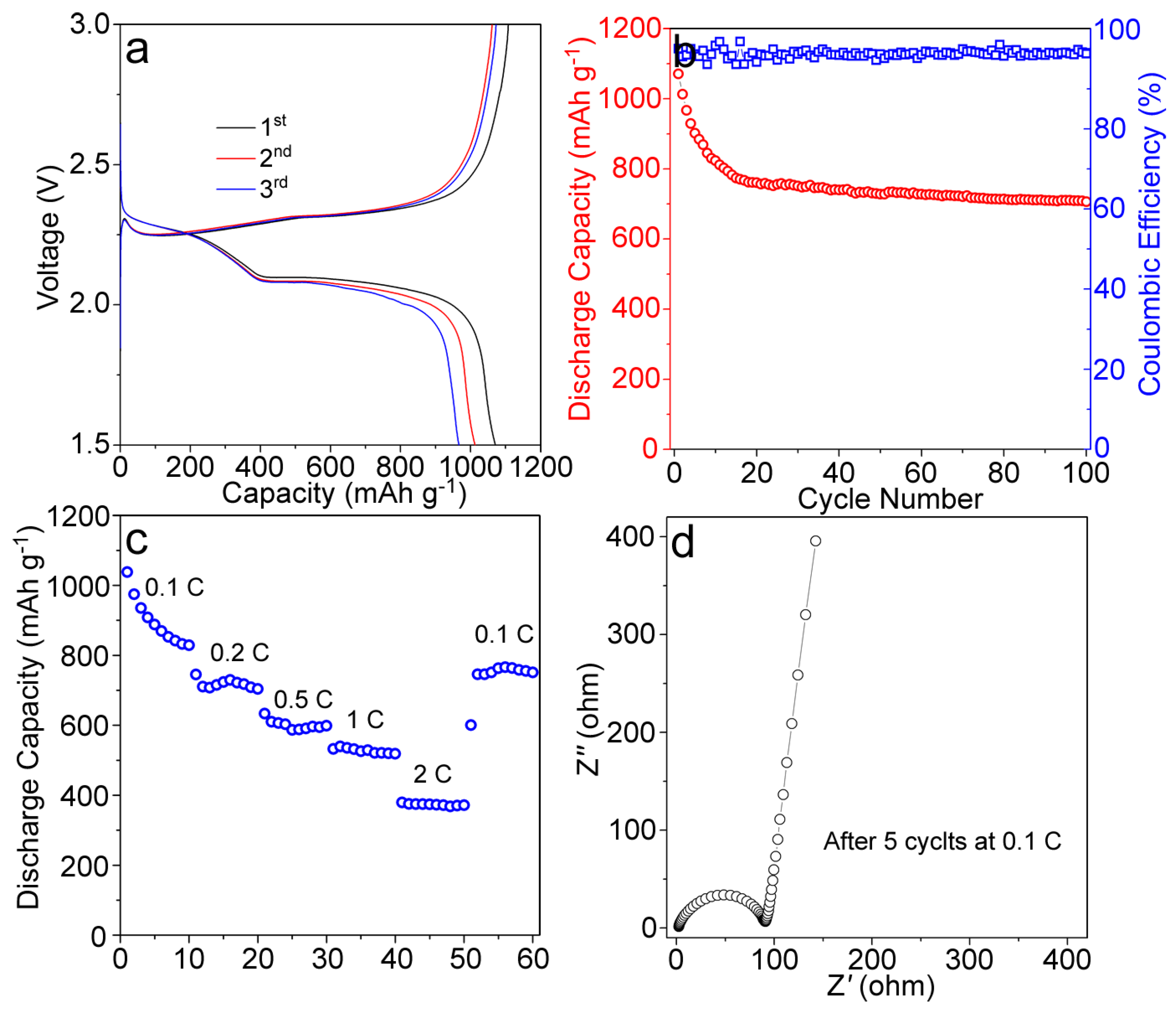Moss-Derived Mesoporous Carbon as Bi-Functional Electrode Materials for Lithium–Sulfur Batteries and Supercapacitors
Abstract
:1. Introduction
2. Experimental
2.1. Preparation of MPC and Activation Process
2.2. Characterization
2.3. Electrode Preparation and Electrochemical Measurements
3. Results and Discussion
4. Conclusions
Author Contributions
Funding
Acknowledgments
Conflicts of Interest
References
- Braff, W.A.; Mueller, J.M.; Francik, J.E. Value of storage technologies for wind and solar energy. Nat. Clim. Chang. 2016, 6, 964–969. [Google Scholar] [CrossRef]
- Miller, J.R.; Simon, P. Electrochemical capacitors for energy management. Science 2018, 321, 651–652. [Google Scholar] [CrossRef] [PubMed]
- Li, G.; Chen, Z.; Lu, J. Lithium-sulfur batteries for commercial applications. Chem 2018, 4, 3–7. [Google Scholar] [CrossRef]
- Daniel, C.; Besenhard, J.O. Handbook of Battery Materials, 2nd ed.; Wiley: New York, NY, USA, 2012. [Google Scholar]
- Manthiram, A.; Fu, Y.; Su, Y.-S. Challenges and prospect of lithium-sulfur batteries. Acc. Chem. Res. 2013, 46, 1125–1134. [Google Scholar] [CrossRef] [PubMed]
- Xu, G.; Ding, B.; Pan, J.; Nie, P.; Shen, L.; Zhang, X. High performance lithium-sulfur batteries: Advances and challenges. J. Mater. Chem. A 2014, 2, 12662–12676. [Google Scholar] [CrossRef]
- Li, Q.; Zhang, Z.; Zhang, K.; Fang, J.; Lai, Y.; Li, J. A simple synthesis of hollow carbon nanofiber-sulfur composite via mixed-solvent process for lithium–sulfur batteries. J. Power Sources 2014, 256, 137–144. [Google Scholar] [CrossRef]
- Chen, L.; Shaw, L.L. Recent advances in lithium-sulfur batteries. J. Power Sources 2014, 267, 770–783. [Google Scholar] [CrossRef]
- Geng, Z.; Xiao, Q.; Wang, D.; Yi, G.; Xu, Z.; Li, B.; Zhang, C. Improved electrochemical performance of biomass-derived nanoporous carbon/sulfur composites cathode for lithium-sulfur batteries by nitrogen doping. Electrochim. Acta 2016, 202, 131–139. [Google Scholar] [CrossRef]
- Jayaprakash, N.; Shen, J.; Moganty, S.; Corona, A.; Archer, L.A. Porous hollow carbon@sulfur composites for high-power lithium–sulfur batteries. Angew. Chem. Int. Ed. 2011, 50, 5904–5908. [Google Scholar] [CrossRef]
- Wang, H.; Yang, Y.; Liang, Y.; Robinson, J.T.; Li, Y.; Jackson, A.; Cui, Y.; Dai, H. Graphene-wrapped sulfur particles as a rechargeable lithium-sulfur battery cathode material with high capacity and cycling stability. Nano Lett. 2011, 11, 2644–2647. [Google Scholar] [CrossRef]
- Xiao, L.; Cao, Y.; Xiao, J. A soft approach to encapsulate sulfur: Polyaniline nanotubes for lithium-sulfur batteries with long cycle life. Adv. Mater. 2012, 24, 1176–1181. [Google Scholar] [CrossRef]
- Zhao, M.; Zhang, Q.; Huang, J.; Tian, G.; Nie, J.; Peng, H.; Wei, F. Unstacked double-layer template graphene for high-rate lithium–sulphur batteries. Nat. Commun. 2014, 5, 3410. [Google Scholar] [CrossRef] [PubMed]
- Cao, R.; Xu, W.; Lv, D.; Xiao, J.; Zhang, J. Anodes for rechargeable lithium-sulfur batteries. Adv. Energy Mater. 2015, 5, 513–537. [Google Scholar] [CrossRef]
- Zhang, S.S. Role of LiNO3 in rechargeable lithium/sulfur battery. Electrochim. Acta 2012, 70, 344–348. [Google Scholar] [CrossRef]
- Zheng, J.; Lv, D.; Gu, M.; Wang, C.M.; Zhang, J.; Liu, J.; Xiao, J. How to Obtain Reproducible results for lithium sulfur batteries. J. Electrochem. Soc. 2013, 160, A2288–A2292. [Google Scholar] [CrossRef]
- Huang, J.; Zhang, Q.; Peng, H.; Liu, X.; Qian, W.; Wei, F. Ionic shield for polysulfides towards highly-stable lithium–sulfur batteries. Energy Environ. Sci. 2013, 7, 347–353. [Google Scholar] [CrossRef]
- Shin, J.H.; Cairns, E.J. N-Methyl-(n-butyl) pyrrolidiniumbis (trifluoromethanesulfonyl) imide-LiTFSI-poly (ethylene glycol) dimethyl ether mixture as a Li/S cell electrolyte. J. Power Sources 2008, 177, 537–545. [Google Scholar] [CrossRef]
- Suo, L.; Hu, Y.-S.; Li, H.; Armand, M.; Chen, L. A new class of solvent-in-salt electrolyte for high-energy rechargeable metallic lithium batteries. Nat. Commun. 2013, 4, 1481. [Google Scholar] [CrossRef]
- Hu, J.; Long, G.; Liu, S.; Li, G.; Gao, X. A LiFSI-LiTFSI binary-salt electrolyte to achieve high capacity and cycle stability for a Li-S battery. Chem. Commun. 2014, 50, 14647–14650. [Google Scholar] [CrossRef]
- Su, Y.S.; Manthiram, A. Lithium-sulphur batteries with a microporous carbon paper as a bifunctional interlayer. Nat. Commun. 2012, 3, 1166. [Google Scholar] [CrossRef]
- Fu, Y.; Su, Y.S.; Manthiram, A. Highly reversible lithium/dissolved polysulfide batteries with carbon nanotube electrodes. Angew. Chem. 2013, 52, 6930–6935. [Google Scholar] [CrossRef] [PubMed]
- Zhou, G.; Li, L.; Wang, D.; Shan, X.; Pei, S.; Li, F.; Cheng, H. A flexible sulfur-graphene-polypropylene separator integrated electrode for advanced Li–S batteries. Adv. Mater. 2015, 27, 641–647. [Google Scholar] [CrossRef] [PubMed]
- Li, G.; Lei, W.; Luo, D.; Deng, Y.; Wang, D.; Chen, Z. 3D porous carbon sheets with multidirectional ion pathways for fast and durable lithium–sulfur batteries. Adv. Energy Mater. 2018, 8, 1702381. [Google Scholar] [CrossRef]
- Shim, J.; Striebel, K.A.; Cairns, E.J. The Lithium/sulfur rechargeable cell effects of electrode composition and solvent on cell performance. J. Electrochem. Soc. 2001, 149, A1321–A1325. [Google Scholar] [CrossRef]
- Wang, J.; Lu, L.; Ling, Z.; Yang, J.; Wan, C.; Jiang, C. Polymer lithium cells with sulfur composites as cathode materials. Electrochim. Acta 2003, 48, 1861–1867. [Google Scholar] [CrossRef]
- Moreno, N.; Caballero, A.; Hernán, L.; Morales, J. Lithium–sulfur batteries with activated carbons derived from olive stones. Carbon 2014, 70, 241–248. [Google Scholar] [CrossRef]
- Hernández-Rentero, C.; Córdoba, R.; Moreno, N.; Caballero, A.; Morales, J. Low-cost disordered carbons for Li/S batteries: A high-performance carbon with dual porosity derived from cherry pits. Nano Res. 2018, 11, 89–90. [Google Scholar] [CrossRef]
- Li, J.; Qin, F.; Zhang, L.; Zhang, K.; Li, Q.; Lai, Y.; Zhang, Z.; Fang, J. Mesoporous carbon from biomass: one-pot synthesis and application for Li-S batteries. J. Mater. Chem. A 2014, 2, 13916–13922. [Google Scholar] [CrossRef]
- Chen, L.; Zhang, Y.; Lin, C.; Yang, W. Hierarchically porous nitrogen-rich carbon derived from wheat straw as an ultra-high-rate anode for lithium ion batteries. J. Mater. Chem. A 2014, 2, 9684–9690. [Google Scholar] [CrossRef]
- Chung, S.H.; Manthiram, A. Carbonized eggshell membrane as a natural polysulfide reservoir for highly reversible li-s batteries. Adv. Mater. 2014, 26, 1360–1365. [Google Scholar] [CrossRef]
- Gao, S.; Li, X.; Li, L.; Wei, X. A versatile biomass derived carbon material for oxygen reduction reaction, supercapacitors and oil/water separation. Nano Energy 2017, 33, 334–342. [Google Scholar] [CrossRef]
- Dong, S.; He, X.; Zhang, H.; Xie, X.; Yu, M.; Yu, C.; Xiao, N.; Qiu, J. Surface modification of biomass-derived hard carbon by grafting porous carbon nanosheets for high-performance supercapacitors. J. Mater. Chem. A 2018, 6, 15954–15960. [Google Scholar] [CrossRef]
- Sun, J.; Niu, J.; Liu, M.; Li, J.; Dou, M.; Wang, F. Biomass-derived nitrogen-doped porous carbons with tailored hierarchical porosity and high specific surface area for high energy and power density supercapacitors. Appl. Surf. Sci. 2018, 427, 807–813. [Google Scholar] [CrossRef]
- Jin, H.; Li, J.; Yuan, Y.; Wang, J.; Lu, J.; Wang, S. Recent progress in biomass-derived electrode materials for high volumetric performance supercapacitors. Adv. Energy Mater. 2018, 8, 1801007. [Google Scholar] [CrossRef]
- Lv, Y.; Gan, L.; Liu, M.; Xiong, W.; Xua, Z.; Zhu, D.; Wright, D.S. A self-template synthesis of hierarchical porous carbon foams based on banana peel for supercapacitor electrodes. J. Power Sources 2012, 209, 152–157. [Google Scholar] [CrossRef]
- Cheng, P.; Gao, S.; Zang, P.; Yang, X.; Bai, Y.; Xu, H.; Liu, Z.; Lei, Z. Hierarchically porous carbon by activation of shiitake mushroom for capacitive energy storage. Carbon 2015, 93, 315–324. [Google Scholar] [CrossRef]
- Tian, W.; Gao, Q.; Tan, Y.; Yang, K.; Zhu, L.; Yang, C.; Zhang, H. Bio-inspired beehive-like hierarchical nanoporous carbon derived from bamboo-based industrial byproduct as high performance supercapacitor electrode material. J. Mater. Chem. A 2015, 3, 5656–5664. [Google Scholar] [CrossRef]
- Cheng, P.; Li, T.; Yu, H.; Zhi, L.; Liu, Z.; Lei, Z. Biomass-derived carbon fiber aerogel as a binder-free electrode for high-rate supercapacitors. J. Phys. Chem. C 2016, 120, 2079–2086. [Google Scholar] [CrossRef]
- Li, Y.; Wang, G.; Wei, T.; Fan, Z.; Yan, P. Nitrogen and sulfur co-doped porous carbon nanosheets derived from willow catkin for supercapacitors. Nano Energy 2016, 19, 165–175. [Google Scholar] [CrossRef]
- Hao, Y.; Xu, F.; Qian, M.; Xu, J.; Zhao, W.; Huang, F. Low-cost and massive preparation of nitrogendoped porous carbon for supercapacitor application. RSC Adv. 2017, 7, 10901–10905. [Google Scholar] [CrossRef]
- Chen, X.; Zhang, J.; Zhang, B.; Dong, S.; Guo, X.; Mu, X.; Fei, B. A novel hierarchical porous nitrogen-doped carbon derived from bamboo shoot for high performance supercapacitor. Sci. Rep. 2017, 7, 7362. [Google Scholar] [CrossRef] [PubMed] [Green Version]
- An, Y.; Li, Z.; Yang, Y.; Guo, B.; Zhang, Z.; Wu, H.; Hu, Z. Synthesis of hierarchically porous nitrogen-doped carbon nanosheets from agaric for high-performance symmetric supercapacitors. Adv. Mater. Interfaces 2017, 4, 1700033. [Google Scholar] [CrossRef]
- Minzae, L.; Gil-Pyo, K.; Hyeon Don, S.; Soomin, P.; Jongheop, Y. Preparation of energy storage material derived from a used cigarette filter for a supercapacitor electrode. Nanotechnology 2014, 25, 345601. [Google Scholar]
- Wang, H.; Xu, Z.; Kohandehghan, A.; Li, Z.; Cui, K.; Tan, X.; Stephenson, T.J.; King’ondu, C.K.; Holt, C.M.B.; Olsen, B.C.; et al. Interconnected carbon nanosheets derived from hemp for ultrafast supercapacitors with high energy. ACS Nano 2013, 7, 5131–5141. [Google Scholar] [CrossRef] [PubMed]
- Li, Z.; Zhang, L.; Amirkhiz, B.S.; Tan, X.; Xu, Z.; Wang, H.; Olsen, B.C.; Holt, C.M.B.; Mitlin, D. Carbonized chicken eggshell membranes with 3d architectures as high-performance electrode materials for supercapacitors. Adv. Energy Mater. 2012, 2, 431–437. [Google Scholar] [CrossRef]






| Biomass Materials | Activator | C/F g−1 | MC | Ref |
|---|---|---|---|---|
| Banana peel | Zinc complexes | 206 | 1.0 A g−1 | [36] |
| Shiitake mushrooms | H3PO4+KOH | 306 | 1.0 A g−1 | [37] |
| Bamboo | KOH | 301 | 0.1 A g−1 | [38] |
| Cotton | KOH | 283 | 1.0 A g−1 | [39] |
| Willow catkin | KOH | 298 | 0.5 A g−1 | [40] |
| Flour | / | 261 | 1.0 A g−1 | [41] |
| Bamboo shoot | Hydrothermal | 270 | 5.0 A g−1 | [42] |
| Agaric | KOH | 324 | 1.0 A g−1 | [43] |
| Cigarette filter | / | 154 | 1.0 A g−1 | [44] |
| Gelatin | NaOH | 281 | 5.0 A g−1 | [45] |
| Eggshell membrane | Air | 297 | 1.0 A g−1 | [46] |
| This work | NaOH | 332 | 1.0 A g−1 | / |
© 2019 by the authors. Licensee MDPI, Basel, Switzerland. This article is an open access article distributed under the terms and conditions of the Creative Commons Attribution (CC BY) license (http://creativecommons.org/licenses/by/4.0/).
Share and Cite
Lei, W.; Liu, H.; Xiao, J.; Wang, Y.; Lin, L. Moss-Derived Mesoporous Carbon as Bi-Functional Electrode Materials for Lithium–Sulfur Batteries and Supercapacitors. Nanomaterials 2019, 9, 84. https://doi.org/10.3390/nano9010084
Lei W, Liu H, Xiao J, Wang Y, Lin L. Moss-Derived Mesoporous Carbon as Bi-Functional Electrode Materials for Lithium–Sulfur Batteries and Supercapacitors. Nanomaterials. 2019; 9(1):84. https://doi.org/10.3390/nano9010084
Chicago/Turabian StyleLei, Wen, Haipeng Liu, Junlei Xiao, Yang Wang, and Liangxu Lin. 2019. "Moss-Derived Mesoporous Carbon as Bi-Functional Electrode Materials for Lithium–Sulfur Batteries and Supercapacitors" Nanomaterials 9, no. 1: 84. https://doi.org/10.3390/nano9010084





